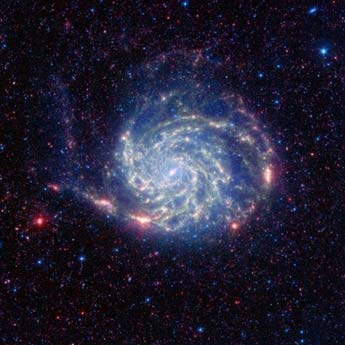|

In a photo provided by NASA, the Pinwheel galaxy, otherwise known as Messier 101, sports bright reddish edges in this new infrared image from NASA's Spitzer Space Telescope. Research from Spitzer has revealed that this outer red zone lacks organic molecules present in the rest of the galaxy. The red and blue spots outside of the spiral galaxy are either foreground stars or more distant galaxies. The organics, called polycyclic aromatic hydrocarbons, are dusty, carbon-containing molecules that help in the formation of stars. Scientists also believe this space dust has the potential to be converted into the stuff of life. Spitzer found that the polycyclic aromatic hydrocarbons decrease in concentration toward the outer portion of the Pinwheel galaxy, then quickly drop off and are no longer detected at its very outer rim. According to astronomers, there's a threshold at the rim where the organic material is being destroyed by harsh radiation from stars.[Agencies]
|

